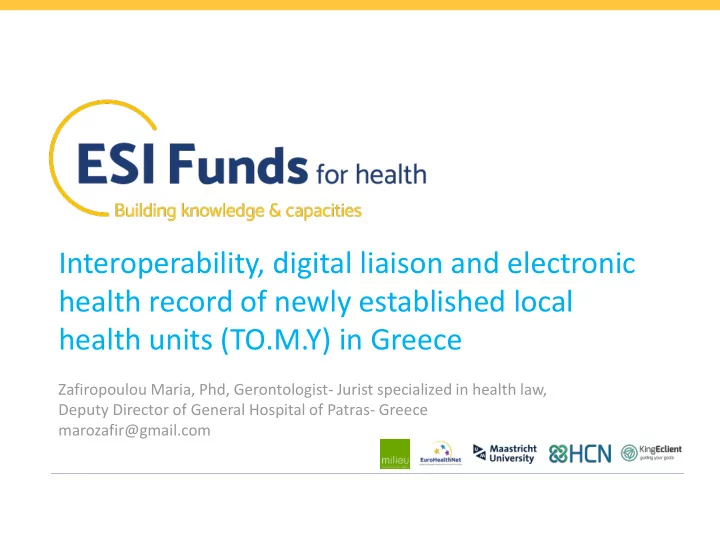

Interoperability, digital liaison and electronic health record of newly established local health units (TO.M.Y) in Greece Zafiropoulou Maria, Phd, Gerontologist- Jurist specialized in health law, Deputy Director of General Hospital of Patras- Greece marozafir@gmail.com 1
TO.M.Y: The newly established primary local health units Local health units (TO.M.Y ) are part of the government’s broader efforts in order to build a newly designed primary health care system with modern, people-centered primary health care services in Greece (WHO, 2017). TO.M.Y are part of ESPA project on "Administrative and organizational reform to increase the efficiency and effectiveness of the public sector". Pilot operation budget: 67.0044.237,46 ESF co-financed: 80% Pilot phase for the construction and operation of 239 TOMY services aiming to cover up to 20-25% of the population in Greece (located especially in urban areas). Till now approximatively 100 TO.M.Y run. 2 The project beneficiary is Health Ministry and its regional health departments.
TO.M.Y’s mission and functioning Their main mission is to provide quality primary health care services to Greek population. Its philosophy is based in Intersectoral teamwork that cooperate with ICT elements (Electronic Health Record- EHR) in monitoring health needs, disease prevention, diagnosis and integrated care. Moreover, TOMY are designed to act as referral mechanisms towards the achievement of a better cooperation between private and public health sector. TO.M.Y are staffed by a multidisciplinary team of up to 12 members consisting of: Four (4) General Doctors or Pathologists • One (1) Pediatrician • Two (2) Nurses • Two (2) Health Visitors • One (1) Social Worker • Two (2) Administrative Employees • 3
Electronic Health Record in TO.M.Y: The “odyssey” of a misinterpreted term In Greece, since 70’s there have been several unsuccessful efforts to • adopt an EHR where the national health system (NHS) has already acquired different electronic medical records (EMRs). Even nowadays, Greek people and even Greek politicians use the terms • “electronic medical record” and “electronic health record” (or “EMR” and “EHR”) interchangeably. This may demonstrate Greek culture and experience in e-health processes and devices. In TO.M.Y, EHR focus on the total health of the patient — going beyond • standard clinical data collected in the provider’s office and inclusive of a broader view on a patient’s care. It contains information such as: Clinical data – diagnostics / Nursing – Operations / Laboratory test Medical recommendations and other medication records Medical actions / Medical history patient summaries - Risk Factors Emergency data sets / Facilitating e-Prescription / Patient Index (AMKA in Greece) 4
The personnel of the TOMY has graded access in the applications of • the EHR, in the electronic scheduling of visits (e-appointment), registration, e-prescribing, referrals to other relevant web applications. More generally, it handles the software that is available for the • proper functioning of TO.M.Y, for an optimal servicing of users and for an interconnection with hospitals while handling and supplementing standardized electronic files. EHR uses ICD -10 (WHO) coding and DRGs which are also used by • Hospitals and health centers. However, other private or smaller public organizations are not keen with this kind of codes and digital groups. This constitutes a challenge for Greek healthcare system itself. 5
Most critical failure factors of TO.M.Y The major problem TO.M.Y experienced, is the lack of interested doctors • to be employed. The negative reaction to any change from the medical, nursing and administrative community is considered as the most critical failure factor of such initiatives. It is currently estimated that only 40% of the needs will be covered. In order to tackle this problem Greek governement increased doctors’ salaries and “borrowed” doctors of regional health centers housing TO.M.Y. Moreover, the software used (HDIKA S.A.) is an old version software not • adapted to actual needs of Greek health system. The majority of public hospitals using HDIKA face a lot of problems of compatibility with other software, speed related problems and highlight the limited options offered. Finally, access by any healthcare professional to EHR during • hospitalization or visit to a public or private health care unit requires the consent of the patient. Consent is given electronically and confirmed by the system. The patient has the right to withdraw his consent at any time and to exclude any use of his or her personal and medical data. This could be a barrier to the generalization of EHR and to its utility. 6
Viability- sustainability of TO.M.Y Originality in times of crisis or in period after crisis: ΤΟΜΥ are • established in public places or in NGOs’ – private buildings which are rent for free or for a symbolic amount of money. The added value of primary health care services regarding cost- • effectiveness is high. Through EHR transparency will be improved, the evaluation of emergency health care services will be assisted, scientific teamwork’s exchange of knowledge will be facilitated by providing longitudinal data tracking of patient. Consequently, the out-of-pocket payments will be reduced and central procurement mechanisms will be improved through an efficient and effective cooperation of the public health administration. 7
Thank you Zafiropoulou Maria, Phd, Gerontologist- Jurist specialized in health law, Deputy Director of General Hospital of Patras- Greece marozafir@gmail.com 8
Recommend
More recommend